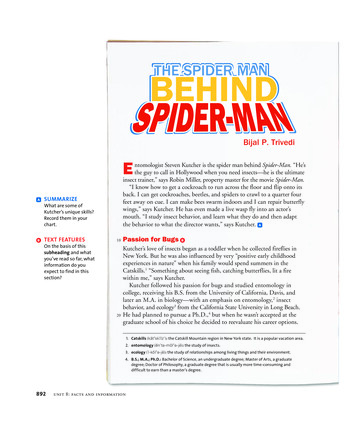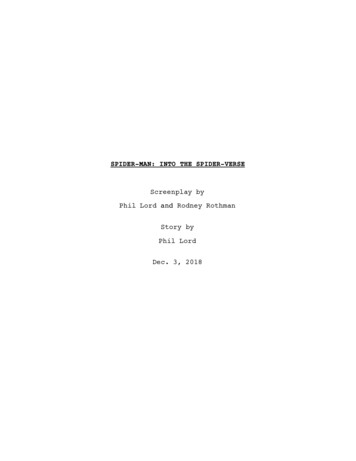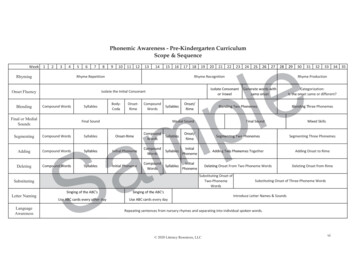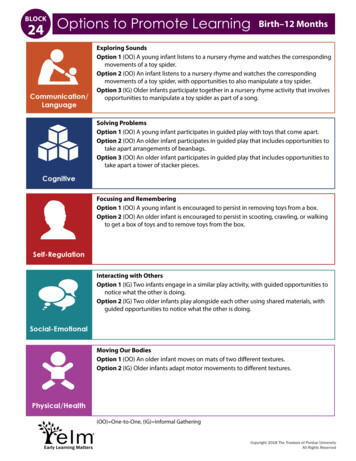
Transcription
Direction of stimulus movement alters fear-linked individual differences in attentionalvigilance to spider stimuli.Julian Basanovic1, Laurence Dean1, John H. Riskind2, Colin MacLeod1, 31Centre for the Advancement of Research on Emotion,School of Psychology, The University of Western Australia, Crawley, Australia2 Department3of Psychology, George Mason University, Fairfax, VA, USADepartment of Psychology, Babeş-Bolyai University, Cluj-Napoca, RomaniaCorresponding author:Julian BasanovicSchool of Psychological Science, The University of Western Australiae-mail: julian.basanovic@uwa.edu.auAcknowledgements:CM was supported in part by Australian Research Council Grant DP170104533. The authorsdeclare no conflict of interest.Keywords: attention; fear; looming; cognition; emotionPublication:Basanovic, J., Dean, L., Riskind, J. H., & MacLeod, C. (2017). Direction of stimulus movementalters fear-linked individual differences in attentional vigilance to spider stimuli. BehaviourResearch and Therapy, 99, 117-123. https://doi.org/10.1016/j.brat.2017.10.004NOTICE: this is the author’s version of a work that was accepted for publication in BehaviourResearch and Therapy. Changes resulting from the publishing process, such as peer review,editing, corrections, structural formatting, and other quality control mechanisms may not bereflected in this document. Changes may have been made to this work since it wassubmitted for publication. A definitive version was subsequently published in BehaviourResearch and Therapy, 99, 117-123. https://doi.org/10.1016/j.brat.2017.10.004
AbstractResearchers have proposed that high spider-fearful individuals are characterised byheightened attentional vigilance to spider stimuli, as compared to low spider-fearfulindividuals. However, these findings have arisen from methodologies that have uniformlyemployed only static stimuli. Such findings do not inform upon the patterns of fear-linkedattentional selectivity that occur in the face of moving feared stimuli. Hence, the presentstudy developed a novel methodology designed to examine the influence of stimulusmovement on attentional vigilance to spider and non-spider stimuli. Eighty participants whovaried in level of spider-fear completed an attentional-probe task that presented stimuliunder two conditions. One condition presented stimuli that displayed an approachingmovement, while the other condition presented stimuli that displayed a recedingmovement. Fear-linked heightened attentional vigilance was observed exclusively under thelatter condition. These findings suggest that fear-linked attentional vigilance to spiderstimuli does not represent a uniform characteristic of heightened spider- fear, but rather isinfluenced by stimulus context. The means by which these findings inform understanding ofattentional mechanisms that characterise heightened spider-fear, and avenues for futureresearch, are discussed.
Running head: MOVEMENT AND ATTENTION TO FEARED STIMULI1IntroductionAcross individuals the physical approach of a potential threat signals increasingprobability of danger and will likely to result in attentional vigilance to the threat and theelicitation of a fear response. For example, observing the sudden approach of a speedingtruck as we cross the road will likely capture our attention and provoke anxiety, leading usto move outside its path. Likewise, if a nesting magpie were to swoop at us from its tree in adisplay of territorial aggression, then the bird will likely capture our attention and provokeanxiety, leading us to move away from the tree. Hence, despite the resulting anxietyresponse, enhanced attentional vigilance to rapidly approaching threats allows for aheightened ability to avoid the danger posed by such threats. Conversely, were it that casethat the same objects were not approaching, for example if the truck or bird were receding,then these objects would be less likely to capture attention and provoke an anxiousresponse.Some theorist have proposed that attentional vigilance to approaching objects, likethose described above, reflects an evolutionary trait present in all individuals that functionsto heighten fear (Hsee, Tu, Lu, & Ruan, 2014) and attentional vigilance (Franconeri &Simons, 2003; Parker & Alais, 2007) in order to limit risk to our well-being posed byenvironmental threats. Specifically, individuals who suffer from specific fears, such as fear ofspiders, have been found to display heightened attentional vigilance to feared stimulirelative to non-feared stimuli. However, despite the plausible impact of approach andreceding movements on attentional vigilance to threatening stimuli, researchersinvestigating individual differences in such patterns of attention have almost exclusivelyemployed static stimuli. For example, using a Stroop-like paradigm researchers havedemonstrated that high spider-fearful individuals, relative to low spider-fearful individuals,
MOVEMENT AND ATTENTION TO FEARED STIMULI2show longer latencies to colour name spider-related words as compared to spider-unrelatedwords, indicating relatively heightened attention to the lexical content of the spider-relatedwords (Kindt & Brosschot, 1997; Watts, McKenna, Sharrock, & Trezise, 1986). Investigatorsusing visual search paradigms have also demonstrated that individuals with heightenedspider-fear display heightened attention to static pictures of spiders. For example, highspider-fearful individuals demonstrate speeded detection of pictures of spiders presentedamongst static arrays of non-spider pictures, such as insects, mammals, or flowers (Öhman& Mineka, 2001; Pflugshaupt et al., 2005; Rinck, Reinecke, Ellwart, Heuer, & Becker, 2005).Additionally, when searching for an insect target stimulus in an array of static spider stimuli,high spider-fearful individuals demonstrate heightened attention towards the spider stimuli,relative to low spider-fearful individuals (Miltner, Krieschel, Hecht, Trippe, & Weiss, 2004;Rinck et al., 2005).Another common paradigm for assessing attentional vigilance to static stimuli inspider-fear is the attentional-probe task (MacLeod, Mathews, & Tata, 1986). In this taskparticipants are presented with pairs of static stimuli, for example an image of a spider andan image of a butterfly. Shortly after, a probe is presented in the location previouslyoccupied by one of the stimuli, and participants must quickly identify the probe. It isassumed that probe identification latencies will be shortest when attention has beenallocated to the where the probe had appeared. Hence, by comparing the speed with whichparticipants correctly identify probes that appear in each stimulus position, the relativedegree to which participants demonstrate attentional vigilance to each of the two stimulican be determined. Using this paradigm, investigators have revealed patterns of probeidentification latencies that are indicative of heightened attentional vigilance to static
MOVEMENT AND ATTENTION TO FEARED STIMULI3spider-related stimuli amongst high spider-fearful individuals as compared to low spiderfearful individuals (Lipp & Derakshan, 2005; Mogg & Bradley, 2006).For individuals with clinical phobia of spiders the movement of spiders, andapproaching movements in particular, often hold a direct motivational meaning, acting as acue of increased likelihood of harm that in turn elevates fear. For example, in their survey ofpatients with spider phobia McNally and Steketee (1985) observed that movement was aparticularly salient and fear-inducing feature of spiders for 77% of respondents. Researchershave also demonstrated that approaching movements specifically are a particular cause ofelevated fear amongst individuals with clinical phobia of spiders. Rachman and Cuk (1992)asked patients with spider phobia and non-phobic controls to observe a live spider in aterrarium and to later report on observed spider behaviour and their level of fear duringviewing. Spider phobic participants, compared to control participants reported observinggreater frequency of approach movements, and greater fear in response to approachmovements. The specific impact on fear of approaching movements made by threat-relatedstimuli, such as spiders, has also been observed amongst individuals generally. Threatrelated stimuli has been observed to elicit heightened activity in cortical regions associatedwith threat processing, and greater fear, when exhibiting approaching movements relativeto when not exhibiting approaching movements (Mobbs et al., 2010; Riskind, 1997; Riskind,Kelley, Harman, Moore, & Gaines, 1992; Sagliano, Cappuccio, Trojano, & Conson, 2014).While some studies have examined attentional processing in response to movingspider stimuli, critically no previous research has directly examined fear-linked differences inattentional vigilance to spider stimuli under conditions where spider stimuli displayapproaching movements. For example, Vrijsen et al. (2009) investigated attentionalvigilance to images of spiders and non-spider objects that simultaneously moved in left,
MOVEMENT AND ATTENTION TO FEARED STIMULI4right, up, or down directions along a path on a computer screen. Alpers, et al. (2009)employed fMRI neuroimaging techniques to assess changes in amygdala activity in the faceof images of spider and birds that were overlaid. Carretié et al. (2009) examined neuralindices of attentional distraction under conditions where a spider stimulus moved across acomputer screen towards participants’ point of attentional fixation. Rinck et al. (2010),presented participants task-irrelevant moving and non-moving spiders within an immersivevirtual environment, observing that spider-fearful participants demonstrated equivalentattention toward static spiders and moving spiders. In considering this finding, Rinck andcolleagues proposed that spiders moving side to side or up and down may be no morethreatening to fearful participants than static spiders, and suggested that the movement ofspider stimuli may moderate attention to a greater degree if the movement was clearlyassociated with changes in potential of danger.Given these findings, conditions under which feared stimuli move in an approachingdirection provide a novel and intriguing circumstance under which to examine fear-linkeddifferences in attentional vigilance to spider stimuli. Hence, the aim of the present studywas to examine fear-linked differences in attentional vigilance to spider stimuli underconditions where stimuli display approaching movements, and to contrast this with fearlinked differences in attentional vigilance to spider stimuli under conditions where stimulidisplay an equivalent amount of movement in a receding direction. Critically, thiscomparison will ensure that any moderating influence of approaching movement implicatesthe direction of movement, and is not simply the result of the presence of movement alone.The study developed a novel variant of the attentional-probe task (MacLeod et al., 1986)capable of measuring attentional vigilance to spider stimuli relative under two conditions.One condition presented stimuli that gradually became larger in size so as to display an
MOVEMENT AND ATTENTION TO FEARED STIMULI5apparent approach movement towards the viewer. A second condition presented stimulithat gradually became smaller size so as to display an apparent receding movement fromthe viewer.A logical contemplation reveals three alternative possibilities that could arise whencomparing fear-linked differences in attentional vigilance to spider stimuli under theseconditions. It may be the case that the discrepancy between approaching movement andreceding movement exerts no effect on fear-linked differences in attentional vigilance tospider stimuli. If this were the case, then fear-linked differences in attention vigilance tospider stimuli would not differ under conditions were spider stimuli display approachingmovement or conditions where spider stimuli display receding movement. Alternatively, itmay be that fear-linked differences in attentional vigilance to spider stimuli are enhancedunder conditions where spider stimuli are approaching, relative to when spider stimuli arereceding. Lastly, it may be that fear-linked differences in attentional vigilance to spiderstimuli are enhanced under conditions where spider stimuli are receding, relative to whenspider stimuli are approaching. By examining fear-linked differences in attentional vigilanceto spider stimuli under conditions where spider-related stimuli are approaching, andconditions where spider-related stimuli are receding, the present methodology willdetermine the validity of each of these alternative possibilities.MethodParticipantsThe purpose of participant recruitment was to create two participant groups thatdiffered in spider fear, with one group representing individuals with relatively higher levelsof spider-fear and one group representing individuals with relatively lower levels of spiderfear. Participants were recruited from a group of 700 undergraduate students who earlier
MOVEMENT AND ATTENTION TO FEARED STIMULI6identified their willingness to be invited to participate in the study as part of a bi-annualstudent recruitment procedure that is conducted by the psychology department at theuniversity. All individuals reserved the right to refuse the invitation to participate.Eighty individuals were recruited to participate. These participants comprised 24males and 56 females, and had a mean age of 18.09 years (SD 1.32, Range, 17 - 23). Duringthe experimental session participants completed the Fear of Spiders Questionnaire (FSQ). Inorder to create two participant groups representing individuals that were relatively higher inspider-fear and individuals that were relatively lower in spider-fear, a median split wasconducted on participants’ FSQ scores. Individuals who fell in the bottom half of this splitwere labelled the Lower Spider-fear Group (N 40, 16 male; Age, M 18.08, SD 1.31; FSQscores, M 13.18, SD 9.01, range 0 - 33), and individuals who fell in the top half of thissplit were labelled the Higher Spider-fear Group (N 40, 8 male; Age, M 18.10, SD 1.36;FSQ scores, M 68.24, SD 21.87, range 34 - 114). This gave rise to a between groupsfactor of Spider-fear Group (Lower Spider-fear Group, Higher Spider-fear Group).MaterialsFear of Spiders Questionnaire. The Fear of Spiders Questionnaire (Szymanski &O’Donohue, 1995) is an 18 item self-report questionnaire that provides a measure of spiderphobia. The questionnaire requires participants to indicate the degree to which theyexperience a range of behaviours and cognitions commonly experienced by spider-fearfulindividuals. Responses are made using a seven-point scale ranging from “Totally Disagree”to “Totally Agree”. Scores on the FSQ range from 0 to 126, with higher scores reflectinggreater fear of spiders. The FSQ has been shown to have high test-retest reliability andconstruct validity amongst undergraduate student populations (Muris & Merckelbach, 1996;Szymanski & O’Donohue, 1995)
MOVEMENT AND ATTENTION TO FEARED STIMULI7Apparatus. The attentional assessment task was run using a PC and a 22-inchwidescreen colour monitor at a resolution of 1920 1080 pixels with a 15 ms refresh rate.Task responses were made using a standard two button mouse.Stimulus images. The attentional assessment task utilised 96 colour images of spidersand 96 colour images of butterflies. These images were selected from images publiclyavailable on the internet. Each image was modified to have a square dimension and a whitebackground. Each image was cropped such that the animal was positioned on as much ofthe image space as possible. An additional set of 24 images was created for use in an initialpractice task. This practice set contained images of typical household objects (e.g.kitchenware) presented on a white background1. All images in the set had a resolution of390 x 390 pixels.Attentional assessment task. The purpose of the attentional assessment task was toassess the degree to which participants demonstrated attentional vigilance to spider imagesas compared to butterfly images. To do so, the task employed the attentional-probemethodology typically used to assess individual differences in attentional vigilance tostimuli. Crucially however, in order to determine whether fear-linked attention vigilance tospider stimuli is enhanced or attenuated in response stimuli that are approaching comparedto stimuli that are receding, the present task incorporated a novel motion manipulation.Specifically, on half of trials stimuli displayed an approaching movement toward theparticipant, whereas on the other half of trials stimuli displayed a receding movement fromthe participant. Notwithstanding the direction of movement displayed by the images, the1The full set of images used in the experiment can be obtained by contacting the corresponding author.
MOVEMENT AND ATTENTION TO FEARED STIMULI8characteristics of trials under each condition closely mirrored conventional methods ofassessing attentional vigilance. These characteristics were as follows.The task contained 384 experimental trials. All trials were presented on a blank whitebackground. Each trial began with the 500 ms presentation of a fixation cue in the centre ofthe screen. After presentation of the cue an image pair was presented. This image pairconsisted of one image of a spider and one image of a butterfly. One image appeared on theleft side of the screen and the other image appeared on the right side of the screen. Thespider and butterfly image appeared in each location with equal frequency across trials. Thecentre of each image was 55 mm from the centre of the screen, subtending a visual angle of10.48 between the centres of each stimulus image at a viewing distance of 60 cm. After500 ms the image pair was removed from the screen and a probe was presented in thelocation previously occupied by one of the preceding images. The probe appeared in eachlocation with equal probability, such that on half of trials the probe appeared in the locationof the spider image and on half of trials the probe appeared in the location of the butterflyimage. The probe comprised a small grey arrow, 5 mm in length, which pointed upward ordownward with equal frequency. Participants were required to indicate the direction thearrow pointed by pressing the corresponding arrow-key on the keyboard. After a correctresponse the screen was cleared and the next trial commenced after a 1000 ms delay. Afteran incorrect response participants were informed via an on-screen message that theirresponse was incorrect and the next trial commenced after a 1000 ms delay. For each trialthe latency and accuracy of participants’ response to the probe was recorded.For each participant, probe identification latencies were used to generate an index ofattentional vigilance to spider images. This Attentional Vigilance to Spider Images Indexexpressed the degree to which identification latencies for probes that appeared in the locus
MOVEMENT AND ATTENTION TO FEARED STIMULI9of spider images were speeded relative to probes that appeared in the locus of butterflyimages. The index was computed using the following calculation:Attentional Vigilance to Spider Images Index (Mean probe identification latency: Probes in locus of butterfly Images) (Mean probe response latency: Probes in locus of spider Images)Hence, increasing positive values on this index represent greater attentional vigilanceto spider images relative to butterfly images, whereas increasing negative values on thisindex score represent greater attentional avoidance of spider images.In order to assess the effect of stimulus movement on attentional vigilance to spiderstimuli experimental trials were equally divided between an Approach Movement Conditionand a Recede Movement Condition. This gave rise to a within-groups factor of StimulusMovement Condition (Approach Movement Condition, Recede Movement Condition). Inorder to display an apparent approaching movement, stimulus images presented in theApproach Movement Condition were presented at a size of 40 mm x 40mm on-screen,before expanding to a size of 60 mm x 60 mm across the full duration of their presentation.In order to display an apparent receding movement, trials in the Recede MovementCondition were presented at a size of 80 mm x 80 mm on-screen, before contracting to asize of 60 mm x 60 mm across the full duration of their presentation. This use of expandingand contracting images has previously been shown to convey apparent approaching andreceding stimulus movements (e.g. Rinck & Becker, 2007; Vagnoni, Lourenco, & Longo,2012). In order to maximise the salience of the moving images on the experimental trials anumber of trials in which stimuli did not move were randomly interspersed across the task.
MOVEMENT AND ATTENTION TO FEARED STIMULI10These 192 trials presented images in fixed sizes of 40 mm x 40mm, 60 mm x 60 mm, and 80mm x 80 mm on-screen with equal frequency. These trials gave rise to a third level in thewithin-groups Stimulus Movement Condition factor (Static Condition).ProcedureUpon arrival to the experimental session participants were provided with aninformation sheet and consent form. Once written consent was obtained participantscompleted the FSQ, before being seated in front of the computer at a viewing distance ofapproximately 60 cm and informed of the requirements of the attentional assessment task.Participants were told to attend to the fixation cue each time it appeared, and to identifythe orientation of the probe each time it appeared by pressing the appropriate responsebutton as quickly and as accurately as possible. The attentional assessment task waspreceded by a short practice version of the task comprising 72 trials using the practicestimulus set. After participants completed the attentional assessment task, they weredebriefed and the session ended.ResultsAccuracy of participants’ probe discrimination responses was reassuringly high (M 97.94%,SD 1.69, range 91.84% - 100%). Prior to computation of Attentional Vigilance to SpiderImages Index scores probe discrimination latencies were filtered to exclude latencies thatwere shorter than 200 ms or that exceeded 2000 ms. Remaining response latencies forcorrectly discriminated probes were used to compute an Attentional Vigilance to SpiderImages Index for trials in delivered the Approach Movement Condition, for trials delivered inthe Recede Movement Condition, and trials delivered in the Static Condition. Aftercomputation of theses scores, any participant who demonstrated an index score greaterthan three standard deviations from the mean index score computed within either
MOVEMENT AND ATTENTION TO FEARED STIMULI11condition were excluded from statistical analysis. One participant from the Lower Spiderfear Group and one participant from the Higher Spider-fear Group had an outlying indexscore. Consequently, these participants were excluded from subsequent analyses. Indexscores for each spider-fear group, under each stimulus movement condition, are presentedin Table 1 below.*TABLE 1 HERE*In order to determine whether the degree to which spider-fear groups differed inattentional vigilance to spider images was affected by the direction of stimulus movement, a2 x 3 mixed-design ANOVA was conducted on Attentional Vigilance to Spider Images Indexscores. This analysis considered Spider-fear Group (Lower Spider-fear Group, Higher Spiderfear Group) as the between-groups factor and Stimulus Movement Condition (ApproachMovement Condition, Recede Movement Condition, Static Condition) as the within-groupsfactor. Though the aim of the present study specifically concerned differences in fear-linkedattentional bias amongst the two directly contrasting movement conditions, the StaticCondition was included in the analysis to allow comparison of the effect of each stimulusmovements on attentional processing relative to conditions where stimuli did not move.The analysis revealed a significant main effect of Stimulus Movement Condition, F(2,152) 7.85, p .001, ηp2 .09, reflecting the fact that, on average, Attentional Vigilance toSpider Images Index scores were slightly larger when stimulus images were static (M 33.21, SD 49.24) as compared to when stimuli were receding (M 32.45, SD 48.54), andwere smallest when stimulus images were approaching (M 21.28, SD 48.02). No maineffect of Spider-fear Group was observed, F(1, 76) 1.44, p .23, ηp2 .02. Importantly, the
MOVEMENT AND ATTENTION TO FEARED STIMULI12analysis did indeed reveal a significant interaction effect involving Spider-fear Group andStimulus Movement Condition, F(2, 152) 3.27, p .041, ηp2 .04. This two-way interactionwas consistent with the possibility that the degree to which spider-fear groups differed inattentional vigilance to spider images was modified by the direction of movement of thestimulus images. The nature of this interaction was examined to determine which level ofStimulus Movement Condition was associated with greatest evidence of fear-relatedattentional vigilance to spiders. The pattern of effects that gave rise to the interaction ispresented Figure 1.*FIGURE 1 HERE*No simple main effect of Spider-fear Group was observed under the Static Condition,F(1, 76) .50, p .48, ηp2 .006 or the Approach Movement Condition, F(1, 76) .39, p .54, ηp2 .005. This indicating that heightened spider-fear was not associated withheightened attentional vigilance to spiders when stimuli were static or approaching. Incontrast to the Approach Condition however, a significant main effect of Spider-fear Groupwas observed under the Recede Movement Condition, F(1, 76) 4.27, p .042, ηp2 .053.This main effect reflected the fact that, when stimulus images were receding, participants inthe Higher Spider-fear Group demonstrated heightened attentional vigilance to spiderimages (M 43.57, SD 48.50) relative to participants in the Lower Spider-fear Group (M 21.33, SD 46.57). Hence, the nature of the interaction effect indicated that participantshigher in spider-fear, as compared to participants lower in spider-fear, did not demonstrateincreased attentional vigilance to spider images that were approaching, but did so for spiderimages that were receding.
MOVEMENT AND ATTENTION TO FEARED STIMULI13DiscussionThe aim of the present study was to investigate the effect of approaching stimulusmovement and receding stimulus movement on fear-linked attentional vigilance to spiderstimuli. The study employed a novel task capable of measuring attentional vigilance tospider stimuli under conditions where spiders and butterflies displayed an approachingmovement towards the viewer, or a receding movement from the viewer. Importantly,results revealed differences in the pattern of fear-linked attentional vigilance to spiderstimuli under approaching and receding stimulus movement conditions. Specifically, higherspider-fearful participants, as compared to lower spider-fearful participants, did not displayheightened attentional vigilance to spider images when images displayed an approachmovement, emulating the pattern of effect observed across static stimuli. However, higherspider-fearful participants, as compared to lower spider-fearful participants, diddemonstrate heightened vigilance to spider images when images displayed a recedingmovement.The present findings carry implications for theoretical accounts of fear-linkedattentional vigilance to feared stimuli. While the present findings have demonstrated thatthe magnitude of fear-linked differences in attentional vigilance to spider stimuli can bedependent upon the movement conditions under which stimuli are presented, theoreticalaccounts of fear-linked differences in attentional vigilance to spider stimuli have most oftenbeen generated from observations of fear-linked heightened attentional vigilance understatic stimulus conditions (Lipp & Derakshan, 2005; Mogg & Bradley, 2006; Pflugshaupt etal., 2005; Rinck et al., 2005). Thus, the present findings encourage novel theories regardingfear-linked patterns of attentional vigilance to feared-stimuli to account for the moderatinginfluence of approaching and receding movements made by feared stimuli.
MOVEMENT AND ATTENTION TO FEARED STIMULI14One plausible theory distinguishes contexts under which attentional vigilance tospider stimuli would be most adaptive, or least adaptive, to the behavioural avoidance ofharm. It is not uncommon for individuals to find themselves in the presence of threats thathave the potential to cause harm, for example in the presence of an oncoming vehicle orswooping bird. On the basis of experimental findings, researchers have proposed that spiderstimuli are likely to represent a threat stimulus across our species, due to an evolutionaryhistory in which spiders have demonstrated the potential to cause harm (Öhman, 2009). It isplausible to speculate that when such threats are approaching individuals will typicallyencode such stimuli as threatening (Hsee et al., 2014) and adopt attentional vigilance to theapproaching stimulus so as to avoid the potential for harm (Franconeri & Simons, 2003).Consequently, under conditions where a spider is approaching it would not be unusual forindividuals to encode the spider as a threat and to implement attentional vigilance to thespider so as to reduce the potential for harm. Conversely if such stimuli are remaining static,or moving away, most individuals would not typically encode the stimuli as threatening, andwould not adopt attentional vigilance to the stimulus. However, some individualsexperience high levels of spider-fear associated with an elevated threat value attributed tospiders. For these individuals, this heightened fear is associated with heightened attentionalvigilance to spider s
2 Department of Psychology, George Mason University, . For individuals with clinical phobia of spiders the movement of spiders, and approaching movements in particular, often hold a direct motivational meaning, acting as a cue of increased likelihood of harm that in turn elevates fear. For example, in their survey of










